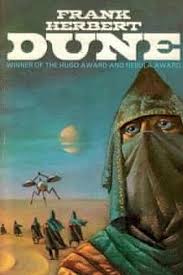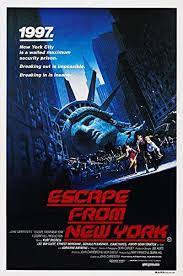
© Warner Bros. Pictures / Legendary Pictures
Denis Villeneuve’s Dune Part Two, sequel to his 2021 sci-fi blockbuster Dune and an adaptation of the second half of Frank Herbert’s 1965 novel of the same name, has been on release for a few weeks now. Though we’ve been busy recently moving apartment, my partner and I found time to watch it yesterday afternoon in our new neighbourhood’s cinema.
The film’s opening 20 minutes weren’t a happy experience for us. Villeneuve immediately plunged us into the action, with Paul Atreides (Timothée Chalamet), his mother Jessica (Rebecca Ferguson), and their Fremen escorts Chani (Zendaya) and Stilgar (Javier Bardem) pinned down on the surface of the desert planet Arrakis by a squad of heavily-armed, black-clad goons from the villainous House of Harkonnen. The tension mounted as the two parties, hunting each other, snuck across the planet’s scorched landscapes of sand and rock… The soundtrack was unnervingly silent… And from right behind us came an incessant cacophony of rustling paper, crackling wrappers, slurpy masticating and greedy chomping. We were attending a 1.30 pm screening of Dune 2 and the couple sitting behind us had decided to guzzle a takeaway lunch while watching the film. I wished a giant Arrakis sandworm would surface directly under their seats and guzzle them.
Finally, the couple managed to finish their meal, their unwelcome sound effects abated and we were able to focus fully on Villeneuve’s movie. So, what did I think of it? Before I give my verdict, here’s a warning. In the entry ahead, there will be spoilers galore for Dune 2.
Well, to be honest, I didn’t enjoy it as much as its predecessor. Mind you, I expected that three years ago as I walked out of Dune 1. As I wrote at the time: “One thing I suspect makes this version of Dune so good is that, in telling only the book’s first half, it’s a story of tragedy. And tragedy, as any student of Shakespeare will confirm, is one of the most powerful forms of narrative. I suspect Villeneuve will find it harder to make the next instalment of Dune, dealing with how Paul marshals his forces and finally restores order on Arrakis, as gripping. For me, at least, downbeat endings last longer in the imagination than happy ones.”
To be fair to Villeneuve and his co-writer John Spaihts, the ending they come up with here is less happy than the one I remember in Herbert’s novel, which I read as a teenager. But the plot, wherein Paul Atreides joins forces with the Fremen, Arrakis’s Bedouin-like natives, and they take on the scumbag Harkonnens, still feels emotionally less complex than that of the original film.

© New English Library
The first film saw Paul’s honourable, though imperialistic father Duke Leto (Oscar Isaac), head of the House of Atreides, get tricked into taking stewardship of Arrakis. There, the House is destroyed by the brutal and grudgeful Harkonnens, with the connivance of the galactic Emperor (the ever-whispery Christopher Walken) and the Bene Gesserit, a female sect with Jedi-like powers who’re secretly manipulating events. Paul and Jessica are among the few survivors and the Fremen reluctantly take them under their wing.
I had some problems with Dune 2’s pacing. Much of the film takes place in the Arrakis desert, where Paul and his mum are gradually initiated into the ways of the natives. Some Fremen are particularly interested in Paul because he seems to fulfil a long-held prophecy about a messiah who’ll come from another world and not only lead them to freedom but make their sandy world green again. While I respect Villeneuve’s efforts at ‘world-building’ here, I feel this section goes on too long. He ladles on the Fremen’s rituals and lore, especially things involving hallucinogenic substances like the spice – the prized commodity, necessary for enabling space travel in the Dune universe, which makes Arrakis such a big political deal in the first place – and the Water of Life, a blue fluid extracted from baby sandworms, the planet’s main non-human lifeform. Though as any Scotsman will tell you, the Water of Life is actually whisky.
Also, the scenes where Paul argues with the Messiah-believing faction of the Freeman (headed by Bardem) that he isn’t really the Messiah put me in mind of the 1979 movie Monty Python’s Life of Brian. While Chalamet tried to convince them that he wasn’t the Chosen One, I kept expecting to hear Terry Jones call out in his raspy old-lady voice: “He’s not the Messiah, he’s a very naughty boy!”

© HandMade Films / Python (Monty) Pictures
Conversely, towards the end, things feel rushed. As Paul and the Fremen escalate their attacks on the Harkonnens, who’ve taken over Arrakis and are trying to supervise its spice production, and the planet slips out of control, the Emperor and his daughter (Florence Pugh) are compelled to make an intervention. They head for Arrakis… And after their spaceship lands at the Harkonnens’ base, Paul and the forces of the Fremen simply turn up, unobserved and unannounced. Until then, we’ve been led to believe that they’re confined to the inhospitable, storm-ridden south of the planet, outside the Harkonnens’ control. How they arrive so quickly and easily, with legions of troops, a cavalry of sandworms and an arsenal of missiles, in the Harkonnens’ backyard is a mystery. It’s as if the planet of Arrakis has suddenly shrunk to being the size of the Isle of Wight.
Meanwhile, certain sub-plots from Herbert’s book don’t quite enrich the movie in the way they could have – or are cut altogether. The return of Paul’s faithful warrior-mentor Gurney Halleck (Josh Brolin) happens abruptly. He just pops up all-of-a-sudden. I’d have liked to know how he survived the massacre in the previous film, especially as we last saw him about to engage the Harkonnens in desperate battle. Gurney brings with him an unexpected revelation about some ‘House Atomics’, nuclear missiles belonging to the Atreides that Duke Leto quietly stashed away on Arrakis. These become a handy bargaining chip for Paul when he points them at the all-important spice fields and are a deus ex machina if ever there was one. I can’t recall if these were in the book – if they were, I assume they were introduced less jarringly.
I do recall the book having an interesting twist whereby Gurney believes Jessica is the one who betrayed the Atreides to the Harkonnens. But there’s zero interaction between the two of them in Dune 2. Rebecca Ferguson, incidentally, deserves praise for her portrayal of Jessica, who grows into a sinister, if not chilling figure as she exerts more and more influence over the Fremen. Gurney would be right to distrust her.
Elsewhere, I was perplexed by the absence of Thufir Harat (Stephen McKinley Henderson in Dune 1). Thufir is a mentat, beings in the Dune universe who do the work of computers. Employed by Paul’s late father, he has a reasonable supporting role in the first film and it’s noticeable that he’s not around in Dune 2. In the novel, the Harkonnens enslave him after their bloody takeover, but then he secretly tries to undermine his new bosses whilst working in their headquarters. In Dune 2, his presence might have solved the problem of how Paul moves his forces to the proximity of the Harkonnens and the Emperor without anyone noticing – Thufir could have deactivated the monitoring systems. Anyway, the film leaves us to surmise that Thufir perished during the slaughter of the Atreides, though Villeneuve thanks McKinley Henderson in the credits, presumably for accepting the dropping of his character with good grace.
Ironically, in the first adaptation of Dune, the 1984 movie directed by David Lynch, which tried to shoehorn the entire novel into two hours and 17 minutes of running time and was derided for leaving so much out, Thufir is shown surviving the Atreides’ massacre and becoming the Harkonnens’ slave. In that version, he was played by Freddie Jones, father of Toby Jones, with big, spidery eyebrows.
All that said, I did enjoy Dune 2. The film was generally impressive and there were moments where I went, “Wow!” Following on from Arrival (2016) and Blade Runner 2049 (2017), it’s good to see Villeneuve again treat a science- fiction story with high seriousness. And I like how, for all that the male characters hog the screen and flaunt their testosterone, it’s implied that the female characters, as portrayed by Ferguson, Charlotte Rampling, Florence Pugh and Lea Seydoux, are the ones really running the show.

© Warner Bros. Pictures / Legendary Pictures
Also great is Villeneuve’s depiction of the Harkonnens. The scenes set on their home planet truly capture their fascistic, creepy, sado-masochistic awfulness, resembling black-and-white footage of rallies in Nazi Germany but populated by the bald-headed Cenobites from Clive Barker’s Hellraiser franchise. Even their fireworks look dark and perverted. And as Feyd-Rautha Harkonnen, the psychopathic nephew of arch-villain Baron Harkonnen (Stellan Skarsgard) who’s drafted in to quell the Fremen’s resistance and restore order on Arrakis, Austin Butler gives possibly the best performance in the film. (In the old David Lynch movie, Feyd-Rautha was the character played by the reggae-loving Geordie, Sting.)
Though Butler just about manages to steal the show, it is one of those films that’s helped immeasurably by its ensemble cast. That includes Timothée Chalamet who, as Paul, has the hardest acting task – he could have ended up a dull goody two shoes or, as he agonises over whether or not he should proclaim himself the Messiah, a whiny pain in the neck. But Chalamet avoids both pitfalls.
Lastly, watching Dune 2, I realised it featured no fewer than three James Bond villains – Walken (Max Zorin in 1986’s A View to a Kill), Bardem (Raoul Silva in 2012’s Skyfall) and Dave Bautista (Mr Hinx in 2016’s Spectre). For good measure, you get a Bond lady too, Lea Seydoux who played Madeline Swann in Spectre and 2021’s No Time to Die. Yes, I know. It’s sad that I notice these things.

© Warner Bros. Pictures / Legendary Pictures




